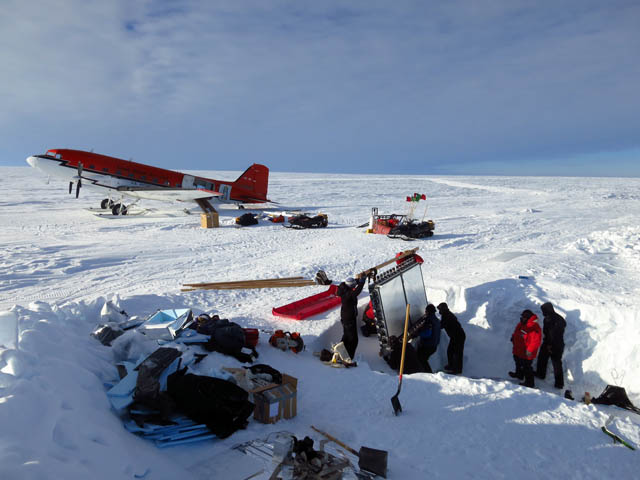
Photo Credit: Lyra Pierotti
|
A Basler aircraft sits nearby the SuperTIGER recovery site in West Antarctica. The instrument had
been nearly buried and required excavation before it could be flown back to McMurdo Station.
|
Page 2/2 - Posted May 4, 2015
Technical difficulties
Hams, along with camp supervisor James King and a mountaineer (myself) spent more a month in the field digging, chopping, and otherwise smashing snow to get the payload out and the skiway flat.
Mechanic Dave White, a former Space Shuttle systems technician for NASA, spent roughly half of the time in the field with the team, also hacking away at the rough snow surface. His most notable contribution was repeatedly rescuing the snowmobile, vital for the grooming effort, from certain mechanical or structural death.
The Antarctic climate can be unforgiving to both people and equipment, and it certainly took its toll on the snowmobile. The first thing to go was the steering, before the team had even left Thomas Hills. Next, the throttle lever broke, which White repaired with wire and epoxy.

Photo Credit: Trevor Williams
Grooming a runway with a snowmobile.
Then the transmission went out. White took it apart, bolted the transmission plate to SuperTIGER, and took a hammer to it, bending and pushing the bearings and seals back into place. He got first gear back, and topped off the transmission fluid with canola oil from the kitchen.
Eventually, the battery died. Fortunately, there were several batteries that had been sitting, buried in the snow, on the SuperTIGER.
King wrangled a battery from the payload, charged it up with the team’s solar array, and then plugged it in to the old snow machine, limping it along for the duration of the recovery.
The team was saved by a battery from “near-space.”
For deep-field skiway grooming missions, teams use a snowmobile specially rigged to tow a groomer, much like a smaller groomer employed at a cross-country ski resort. It’s essentially a heavy metal trailer with various sizes of teeth designed to chop and drag snow around until the surface is flat and long enough for whatever size airplane is going to land.
For this recovery mission, the Basler would provide the necessary cargo space to recover all detectors intact. The Basler is a modified DC-3, the airliner that revolutionized air transport in the 1930s and 1940s. This plane typically requires about a mile of groomed skiway on which to land and take off again.
Though the snow surface was significantly smoother this season over last, White’s first impression, he said, was that it looked like the moon.
“There were enough deep holes,” he said, “and waist-high sastrugi to kill a bulldozer.”
The snow surface proved stubborn enough to take almost twice as long as previous snowmobile-groomed skiways, according to King.

Photo Credit: SuperTIGER
The SuperTIGER payload spent 55 days aloft.
Long, strange trip
All obstacles, setbacks, delays, plan changes, breakdowns, upside-downs, detours, and weather days aside, SuperTIGER returned safely to McMurdo, just in time to be packaged and shipped home in January on the cargo vessel – including the intact aerogel.
Predictable was never a descriptor for the SuperTIGER Long Duration Balloon even when it was aloft.
The balloon’s flight was terminated, in part, because it was approaching the end of the 2012-13 LDB flight season, but mostly because the polar vortex was becoming unstable.
NASA’s Columbia Scientific Balloon Facility, which operates the LDB site near McMurdo, uses satellite data to forecast high-altitude winds.
“Towards the end of the [SuperTIGER] flight,” Hams said, “the forecast for the next few days suggested a departure from circumpolar wind patterns that could have taken the balloon farther south, potentially into the mountains.”
The polar vortices are persistent, large-scale cyclones that circle the planet’s geographical poles. They drive the winds at altitudes around 120,000 feet where the balloon flies.
The winds are circumpolar: half the year they go one way, and the other half of the year they go the opposite way. At this “turnaround,” the winds have eddies and become unpredictable, Hams explained. When the vortex becomes unstable, the balloon’s trajectory becomes less predictable.
The trouble is that if the winds push the balloon too far north, it may end up over the ocean. This is not ideal, as most payloads are not buoyant and contain electronics that would corrode or short-out in the seawater.
On the other hand, if the payload lands too far south, it could end up over the Transantarctic Mountains, where terrain would make recovery difficult at best – or worse, the mission would be a very expensive trash pickup.

Photo Credit: Lyra Pierotti
A stuff tiger that flew on the SuperTIGER balloon poses in front of the South Pole geographic marker.
In summary, Hams said, “When you land on a slope, it just goes downhill.”
Tiger by its tail
But it wasn’t all hard science and hard-packed snow out there.
Soon after the field team had started digging, Sean Fitzsimmons, a NASA test engineer on standby for the recovery, wanted to know if we found “the tiger.”
“The tiger was a gift for my mother-in-law when she had cancer,” he said.
When SuperTIGER was getting ready for Antarctica, Fitzsimmons said he started sending the stuffed tiger around with the payload.
“It went from Goddard in Maryland to Texas, then to the Ice where last minute we decided to strap it to the payload and let it fly,” he said.
Now, after two years in remission, Fitzsimmons’ mother-in-law said she is happy and honored to have the tiger back. And, she reports, he has found a happy home in her stuffed bear collection – no lost limbs, or even singed whiskers to show for the epic journey.
Previous
1
2
Next








